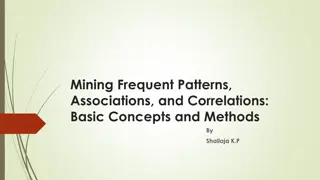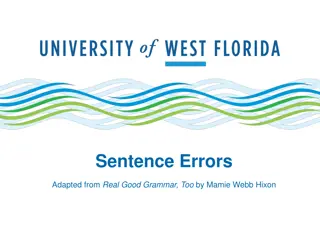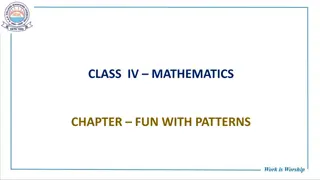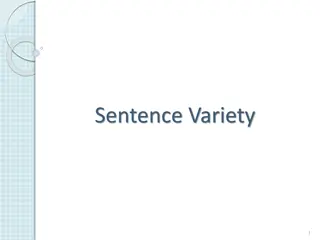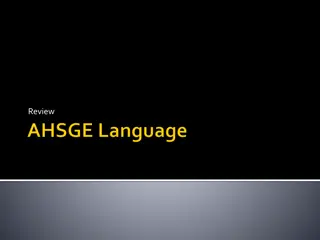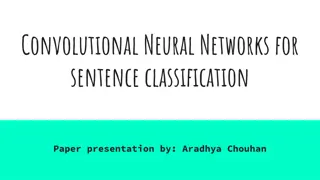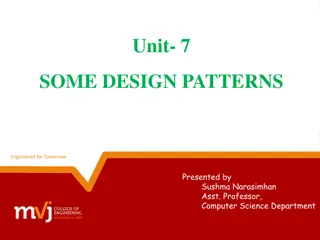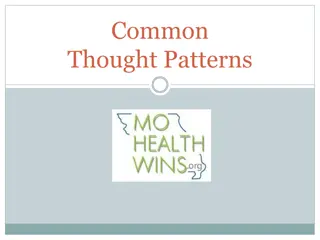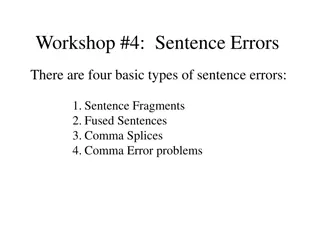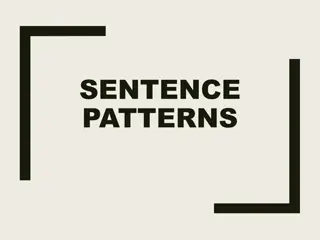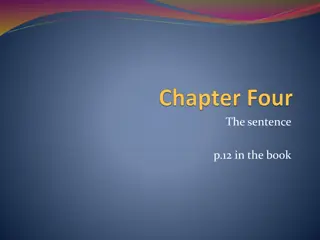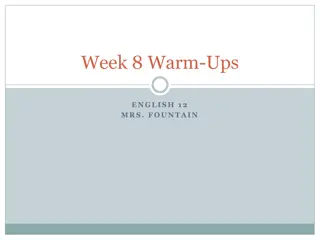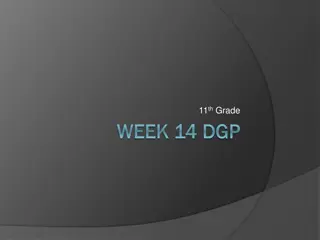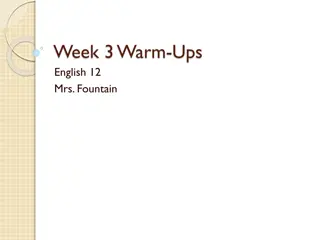Understanding Sentence Patterns in Language: A Guide by Prof. Dr. Nalan Kiziltan
Language consists of sentences organized by grammar rules. Syntax plays a crucial role in sentence structure. This guide explores sentence patterns, syntax principles, linear order, and hierarchical structure in language, illustrated with examples and constituent tests.
Download Presentation

Please find below an Image/Link to download the presentation.
The content on the website is provided AS IS for your information and personal use only. It may not be sold, licensed, or shared on other websites without obtaining consent from the author. Download presentation by click this link. If you encounter any issues during the download, it is possible that the publisher has removed the file from their server.
E N D
Presentation Transcript
The Sentence Patterns of Language Prof. Dr. Nalan KIZILTAN
The language is the set of sentences that are described by the grammer. The grammer generates the sentences it describes and their structural descriptions. Chomsky(1957) Knowing a language includes the ability to put words together to form phrases and sentences that express our thoughts. That part of the grammer that represents a speaker s knowledge of the structure of phrases and sentences is called Syntax.
Sequences of words that conform to the rules of syntax are well formed or grammatical. Sequences of words that violate the syntactic rules are ungrammatical. There are two basic principles of sentence organization: Linear Order Hierarchical Structure
LINEAR ORDER The words in a sentence must occur in a particular sequence if the sentence is to convey the desired meaning. 1) John glanced at Mary. 2) Mary John at glanced. 3) Mary glanced at John. (the meaning is completely different from that of (1).
HIERARCHICAL STRUCTURE The individual words in a sentence are organized into natural, semantically coherent groupings which are themselves organized into larger groupings. These groupings within a sentence are called constituents of that sentence. The relationships between constituents in a sentence form the constituent structure of the sentence.
4) Many executives eat at really fancy restaurants. Have meaning of their own. And each makes a coherent contribution to the meaning of (4) as a whole. Many executives Eat at really fancy restaurants. These are constituents
Constituent Tests 1) Ability to stand alone Constituents can be used alone as exclamations or as answers to questions. 5) What do many executives do? Eat at really fancy restaurants.
2) Substitution by a pro-form A constituant can be replaced by a single word having the same meaning. Pronouns are one type of pro-form; such as do, be, have; pro-adverbs such as there and then; as well as a pro-adjectives. 6) They eat at really fancy restaurants - Who eats at really fancy restaurants? 7) Many executives do.
3) Movement If some part of a sentence can be moved around usually to the beginning or end of the sentence it is a constituent. 8) At really fancy restaurants, many executives eat. 9) How fancy was it? - Really fancy 10) Who eats at really fancy restaurants? Many executives eat at such restaurants.
11) Many executives eat at really fancy restaurants.
In addition to the linear order of words in a sentence, a tree diagram is another way of representing the hierarchical nature of constituent structure. Branching structures in which each constituent forms a branch Many executives eat at really fancy restaurants. many executives eat at really fancy restaurants. many executives eat at really fancy restaurants. at really fancy restaurants really fancy restaurants fancy restaurants
The child found the puppy the child found the puppy the child found the puppy the puppy
Ambiguity In every human language we can find individual expressions which have two or more distinct meanings. 12) Long raises miniature badgers and raccoons. long raises miniature badgers and raccoons. raises 1 miniature badgers and raccoons. miniature badgers and raccoons. badgers and raccoons.
2 miniature badgers and raccoons. miniature badgers and raccoons. miniature badgers
13) We need more intelligent leaders we 1 need more intelligent leaders need more intelligent leaders more intelligent leaders (A greater quantity of intelligent leaders)
14) more intelligent leaders more intelligent leaders more intelligent (Leaders who are more intelligent) Structural ambiguity can be explicitly accounted for by multiple tree structures.
In (13) Intelligent leaders is a constituent: for this reason (13) represents the interpretation a greater quantity of intelligent leaders. In (14), however, more intelligent forms a constituent: (14) therefore represents the meaning leaders who are more intelligent. Although structural ambiguity is a very common kind of ambiguity, it is not the only kind. Individual words are sometimes ambiguous: for example, crane can refer to either a kind of bird or to a large construction device. Because words like crane have no internal constituent structure, sentences containing such words clearly can`t be structurally ambiguous. Instead, a sentence containing a word with more than one meaning is said to be lexically ambiguous. Thus, both meanings for (13)-(14) are represented with the same constituent structure.
EXERCISES 0. Apply the constituent tests to determine if the underlined expressions in the following sentences are constituents. a. Many retired workers spend their time on relaxing hobbies. b. Many retired workers spend their time on relaxing hobbies. c. Many retired workers spend their time on relaxing hobbies.
1) Which of the underlined expressions in the following sentences are constituents? Which are not? Why? (Use the constituency tests mentioned before to show this in each case.) a. Marianne ate the stale candy. b. Marianne ate the stale candy c. My little brother snores. d. My little brother snores.
2) Apply each of the constituency tests to the underlined expressions and determine whether they are constituents. a. The clouds rolled across the sky. b. My uncle crushed our new car c. Mattingly hit the ball over the fence. d. Some students hate computers. e. The ancient ruins of the temple were covered by the earth. f. The women wept. g. Too many noisy birds are nesting on campus. h. Joggers like to run along the river. i. The bride and groom ran out of the church.
SYNTACTIC RULES 1) The rules of syntax combine words into phrases phrases into sentences English: SUBJECT - VERB - OBJECT (SVO) language Turkish: SUBJECT - OBJECT - VERB (SOV) language 2) Syntactic rules also specify other constraints that sentences must adhere to. a) To find + NP = YES * To find + ADV = NO b) To sleep + ADV = YES * To sleep + NP = NO
3) Syntactic rules show how words form groups in a sentence Syntactic rules show how they are hierarchically arranged with respect to one another. 4) Syntactic rules reveal the grammatical relations among the words of a sentence as well as their order and hierarchical organization. 5) Syntactic rules explain how the grouping of words relates to its meaning, such as when a sentence or phrase is ambiguous.
6) The rules of syntax permit speakers to produce and understand a limitless number of sentences never produced are heard before the creative aspect of Linguistic knowledge. A major goal of linguistics is to show clearly and explicitly how syntactic rules account for this knowledge. A theory of grammar must provide a complete characterization of what speakers implicitly know about their knowledge.
WHAT GRAMMATICALITY IS NOT BASED ON Grammaticality meaningfulness. Colorless green ideas sleep furiously. A verb crumpled the milk Syntactically well formed Semantically not acceptable=Nonsense Grammaticality does not depend on the truth of sentences. If it did, lying would be impossible. The syntactic rules that permit us to produce, understand, make grammaticality judgements are unconscious rules. The grammar is a mental grammar, different from the prescriptive one.
(7) S= NP + VP John snored. Everyone fled the volcano. The major smoked a cigar. A book lay on the table. (8) NP= Det + N the mayor a book every student my python
(9) VP= V + NP fled the volcano smoked a cigar imitated a flamingo squeezed some fresh orange juice We can represent these tree pieces of information in a succinct way with the following three phrase structure rules. (10) S NP VP (11) NP Det N (12) VP V NP
The arrow in these rules can be read as may consist of. Thus rule (10) is just a concise way of saying a sentence may consist of a noun phrase followed by a verb phrase ; similarly, rule (11) just says a noun phrase may consist of a determiner followed by a noun. Now, what does rule (12) say? Recall from File 52 that a syntactic category is a group of constituents with different structures which share certain properties. NP s, for example, could be composed of DET + N, as in (2) above, bur they may also have the following structures: (13) My uncle from France A rule for this NP would look like: (14) NP NP PP
Rules (10) (11) (12) and (14) specify five ways in which constituents can be combined to form larger, more complex constituents. Some constituents, however, do not result from the combination of smaller constituents; instead, they consist of a single word. For example, a noun phrase may just consist of a proper name (e.g., John, Paris), a plural noun (e.g., elephants, leaves), or a noun referring to a substance (e.g., clay, gasoline); similarly, a verb phrase may just consist of an intransitive verb such as sneeze, die, vanish, or elapse. These sorts of knowledge can also be represented with PS rules: 15 NP N 16 VP V
Phrasal Categories A phrasal category is a set of constituents which behave the same or share the same functions and distribution. Noun Phrase (NP) A noun or a noun + other words (1) ____________ ran through the park. a) susan e) some children b) students f) a huge lovable bear c)you g) my friend from turkey d) most dogs h) the people that we interviewed 1)
2) Verb Phrase (VP) a single verb or verb + other forms verb + ADV verb + NP+ PP (prepositional phrase) (2) John ________. a) saw a clown b) is smart c) slept d) found the cake e) found the cake in the cupboard
3 Adjective Phrase a single adjective or as a constituent of NPs. (3) John is ____________. a) smart b) very intelligent c) as tall as his father d) smarter than the average bear e) certain to win
4 Adverbial Phrase and ADVPs. (4) John speaks ____________. a) fluently b) as fluent as a native c) almost certainly 5 Prepositional Phrase preposition followed by a NP. a) from Turkey b) at university c) through the park d) in the cupboard Adverbor as a constituent of VPs
6) Sentences are often used by themselves. (5) it is raining. I like apple pie.
Phrase Structure Trees A diagram with syntactic category information provided is called phrase structure tree. This tree shows that a sentence is both a linear string of words and hierarchical structure with phrases nested in phrases. Three aspects of speakers syntactic knowledge of sentence structure are disclosed in phrase structure trees: 1 the linear order of the words in the sentence 2 the groupings of words into syntactic categories 3 the hierarchical structure of the syntactic categories
Sentence NP VP V NP
(1) The child found the puppy S NP VP Det N Vt NP Det N the child found the puppy
(2) my mother likes her cats S VP NP Vt NP N Det N Det my mother likes her cats
(3)Many retired workers spend their time on relaxing hobbies. S NP VP PP Vt NP Det ADJ N NP N P Det ADJ N many retired workers spend their time on relaxing hobbies
(4) The boy saw the man with the telescope S VP NP PP Vt NP Det N Det NP N P Det N the boy The boy used a telescope to see the man. saw the man with the telescope
(5) The boy saw the man with the telescope S VP NP Vt NP Det N Det N PP NP P Det N the boy saw the man with the telescope
(6) The baby slept S NP VP N Det Vit the baby slept
(7) the girl with the feather on the ribbon on the brim. NP PP Det N NP P Det PP N P NP PP Det N NP P N Det the girl with the feather on the ribbon on the brim
One can repeat the number of NPs under PPs under NPs without a limit. This property of all human languages is called recursion. (infinite recursion) (productivity)
The man fled from the posse. S VP NP Vit PP N Det P NP Det N the man fled from the posse.
A girl laughed at the monkey. S VP NP PP Vit N Det NP P Det N a girl laughed at the monkey
A large fierce black dog looked out the window. S NP VP Det Adj PP Adj Adj N Vt NP P Det N a large fierce black dog looked out the window.
The man in the kitchen drives a truck. S NP VP NP PP NP Vt NP P Det N N Det Det N the kitchen drives a truck. the man in
Lexical Categories Each word in a given language is not entirely different in its behavior from all the other words in that language. Instead, a large number of words exhibit the same properties. Words can be grouped into some word classes based on their morphological and syntactic properties. These word classes are called lexical categories, because the lexicon is the list of all the words in a language (plus various kinds of information, about those words.) For example, one of the morphological properties of the word book is that it has a plural form books. All these words can occur in the following context:
(1) __________ + plural morpheme. The words that occur in the morphological frame can also occur in the syntactic frames as in (2) and (3): (2) DET _________ (3) DET ADJ _________ Verbs (4)_________ + tense morpheme (sing-song; walk-walked) (5)________ + third person singular morpheme (I walk, he walks) (6)_________ + progressive morpheme (I am walking) (7)AUX__________ (may go) (8) (please)___________! ((please) leave!)
Adjectives (9)_________ + er/est (taller, tallest) (10) more/most+ _____(more affectionate, most affectionate) (11) DET____________ N (the unexpected guests) (12) Linking verbs__________(looks sunny) (13) ADV___________(amazingly perceptive) Adverbs (14) ADV (ADJ+ly) (happily, unexpectedly, skillfully) (15) ________ ADJ (unusually nice) __________VERB or VERB PHRASE (usually go) __________ ADV (quite well)




